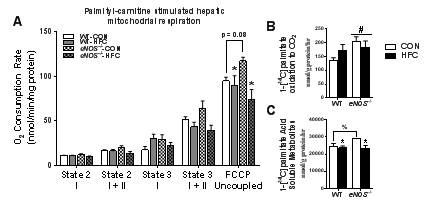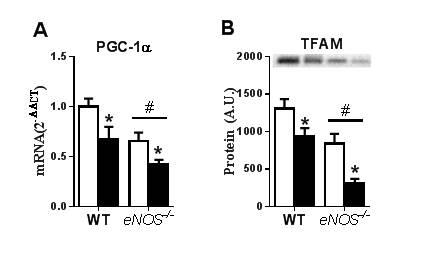Difference between revisions of "Sheldon 2015 Abstract MiPschool Greenville 2015"
| (6 intermediate revisions by 3 users not shown) | |||
| Line 1: | Line 1: | ||
{{Abstract | {{Abstract | ||
|title= | |title=eNOS is required to preserve hepatic mitochondrial function in western diet-induced nonalcoholic fatty liver disease. | ||
|authors=Sheldon RD, Linden MA, Morris EM, Meers GM, Laughlin MH, Rector RS | |authors=Sheldon RD, Linden MA, Morris EM, Meers GM, Laughlin MH, Rector RS | ||
|year=2015 | |year=2015 | ||
|event=MiPschool Greenville 2015 | |event=MiPschool Greenville 2015 | ||
|abstract= | |abstract=Endothelial nitric oxide synthase (eNOS) produces physiological concentrations of nitric oxide that can influence mitochondrial biogenesis and electron transport chain activity. Hepatic mitochondrial dysfunction is a hallmark feature of nonalcoholic fatty liver disease (NAFLD), yet the underlying mechanisms of this phenomenon remain elusive. Here, we tested the hypothesis that eNOS is required for proper hepatic mitochondrial function in NAFLD. Wild-type (WT) and eNOS knockout (eNOS-/-) mice received either control (CON; 10% fat, 3.5% sucrose) or a western diet high in fat (45%), sucrose (17%) and cholesterol (1%; HFC) for 18-weeks. HFC diet feeding induced histological NAFLD and increased weight gain and % body fat in both genotypes compared to CON diet. Complete hepatic mitochondrial palmitate oxidation to CO<sub>2</sub> was elevated in both eNOS-/- groups compared with WT mice (''p''<0.05), while incomplete acid-soluble metabolite production was elevated only in eNOS-/--CON compared to other groups. In addition, maximal FCCP-uncoupled mitochondrial respiration tended to be elevated in eNOS-/--CON compared to WT-CON (+24%; p=0.08) but was significantly reduced with HFC feeding in eNOS-/- mice (-37% vs eNOS-/--CON; ''p''<0.05). Finally, HFC feeding dramatically reduced hepatic mRNA expression of the putative control marker for mitochondrial biogenesis, PGC-1α, in WT (-30%) and eNOS-/- (-60%) compared with WT-CON (''p''<0.05). These data suggest that eNOS-/- mice are more susceptible to Western diet-induced hepatic mitochondrial dysfunction that may be related to an impaired capacity to generate new, healthy mitochondria. | ||
|mipnetlab=US MO Columbia Rector RS | |mipnetlab=US MO Columbia Rector RS | ||
}} | }} | ||
{{Labeling | {{Labeling | ||
|area=Respiration, Exercise physiology;nutrition;life style | |area=Respiration, mt-Biogenesis;mt-density, Exercise physiology;nutrition;life style | ||
|organism= | |organism=Mouse | ||
| | |tissues=Liver | ||
|couplingstates=LEAK, OXPHOS, | |couplingstates=LEAK, OXPHOS, ET | ||
| | |pathways=N, NS | ||
|instruments=Oxygraph-2k | |instruments=Oxygraph-2k | ||
|event=Oral | |||
}} | }} | ||
== Affiliations == | == Affiliations == | ||
Harry S Truman Memorial Veterans Med Center and Univ Missouri, Columbia, MO, USA - [email protected] | |||
== | == Figures == | ||
[[Image:MiPschool2015Greenville Sheldon | [[Image:MiPschool2015Greenville Sheldon Figure1.jpg|left|600px]] Figure 1. Functional measures of isolated hepatic mitochondria. *; Main effect of diet. #; Main effect of genotype. %; significant interaction, eNOS-/--HFC different from WT-HFC. $; significant interaction, eNOS-/--CON different from eNOS-/--HFC. | ||
[[Image:MiPschool2015Greenville Sheldon Figure2.jpg|right|600px]] Figure 2. Markers of mitochondrial biogenesis in whole liver homogenate. *; Main effect of diet. #; Main effect of genotype. %; significant interaction, eNOS-/--HFC different from WT-HFC. $; significant interaction, eNOS-/--CON different from eNOS-/--HFC. | |||
== Support == | |||
Supported by: HL036088 (MHL) and VHA-CDA2 1299-03(RSR) | |||
Latest revision as of 16:02, 13 November 2017
| eNOS is required to preserve hepatic mitochondrial function in western diet-induced nonalcoholic fatty liver disease. |
Link:
Sheldon RD, Linden MA, Morris EM, Meers GM, Laughlin MH, Rector RS (2015)
Event: MiPschool Greenville 2015
Endothelial nitric oxide synthase (eNOS) produces physiological concentrations of nitric oxide that can influence mitochondrial biogenesis and electron transport chain activity. Hepatic mitochondrial dysfunction is a hallmark feature of nonalcoholic fatty liver disease (NAFLD), yet the underlying mechanisms of this phenomenon remain elusive. Here, we tested the hypothesis that eNOS is required for proper hepatic mitochondrial function in NAFLD. Wild-type (WT) and eNOS knockout (eNOS-/-) mice received either control (CON; 10% fat, 3.5% sucrose) or a western diet high in fat (45%), sucrose (17%) and cholesterol (1%; HFC) for 18-weeks. HFC diet feeding induced histological NAFLD and increased weight gain and % body fat in both genotypes compared to CON diet. Complete hepatic mitochondrial palmitate oxidation to CO2 was elevated in both eNOS-/- groups compared with WT mice (p<0.05), while incomplete acid-soluble metabolite production was elevated only in eNOS-/--CON compared to other groups. In addition, maximal FCCP-uncoupled mitochondrial respiration tended to be elevated in eNOS-/--CON compared to WT-CON (+24%; p=0.08) but was significantly reduced with HFC feeding in eNOS-/- mice (-37% vs eNOS-/--CON; p<0.05). Finally, HFC feeding dramatically reduced hepatic mRNA expression of the putative control marker for mitochondrial biogenesis, PGC-1α, in WT (-30%) and eNOS-/- (-60%) compared with WT-CON (p<0.05). These data suggest that eNOS-/- mice are more susceptible to Western diet-induced hepatic mitochondrial dysfunction that may be related to an impaired capacity to generate new, healthy mitochondria.
• O2k-Network Lab: US MO Columbia Rector RS
Labels: MiParea: Respiration, mt-Biogenesis;mt-density, Exercise physiology;nutrition;life style
Organism: Mouse
Tissue;cell: Liver
Coupling state: LEAK, OXPHOS, ET Pathway: N, NS HRR: Oxygraph-2k Event: Oral
Affiliations
Harry S Truman Memorial Veterans Med Center and Univ Missouri, Columbia, MO, USA - [email protected]
Figures
Figure 1. Functional measures of isolated hepatic mitochondria. *; Main effect of diet. #; Main effect of genotype. %; significant interaction, eNOS-/--HFC different from WT-HFC. $; significant interaction, eNOS-/--CON different from eNOS-/--HFC.
Figure 2. Markers of mitochondrial biogenesis in whole liver homogenate. *; Main effect of diet. #; Main effect of genotype. %; significant interaction, eNOS-/--HFC different from WT-HFC. $; significant interaction, eNOS-/--CON different from eNOS-/--HFC.
Support
Supported by: HL036088 (MHL) and VHA-CDA2 1299-03(RSR)

